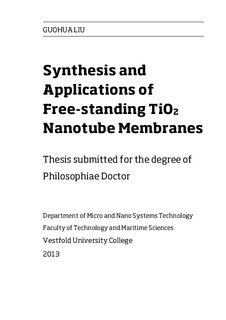| dc.contributor.author | Liu, Guohua | |
| dc.date.accessioned | 2013-05-03T08:59:07Z | |
| dc.date.available | 2013-05-03T08:59:07Z | |
| dc.date.issued | 2013 | |
| dc.identifier.citation | Liu, G. (2013). Synthesis and Applications of Free-standing TiO2 Nanotube Membranes (Doctoral thesis at Vestfold University College, [Tønsberg]). | no_NO |
| dc.identifier.isbn | 978-82-7860-233-1 | |
| dc.identifier.issn | 1893-7500 | |
| dc.identifier.uri | http://hdl.handle.net/11250/149102 | |
| dc.description | Papers in this thesis are not available in this archive due to publishers' restrictions | no_NO |
| dc.description.abstract | Nanostructured TiO2 nanotubes (TNTs) have great application potential in optoelectronic devices due to large effective light harvesting surface area and wide band gap. Anodization of Ti is a simple way to prepare well-ordered nanostructured TiO2 in the form of vertically oriented TNTs. Compared with dense nanoparticles, TNTs facilitate charge transport along the tube direction while maintaining a high effective surface area, and thus suitable for a variety of applications such as sensors, water splitting, photovoltaic devices, CO2 conversion, supercapacitors etc.
In order to form a well-ordered tubular structure with controlled morphology, a balance between oxidation and field-assisted dissolution has to be maintained by adjusting electrolyte concentration, temperature, anodic duration, ramp rate and the applied potential. However, the nature of TNTs attached to an opaque Ti foil and with a closed bottom limits their feasibility for use in extensive applications. Therefore, built upon suitable fabrication approaches that enable free-standing TNT membranes as well as the investigation of their photoconductive properties so that create environmental friendly alternative energy sources are the motivations of this work.
This Ph.D. work focuses on the challenging issues: i) improve the tune quality of highly ordered TNTs by reproducible manner. ii) Investigate pioneered technologies to prepare the free-standing TNT membrane as well as mechanism behind the detachment process. iii) Explore the photoconductive property of the TNTs. Following progresses have been made towards the target.
Article I provided an overview of all technologies to prepare free-standing TNT membranes. The developments of structural optimization techniques of the detached membrane are described from electrochemistry point of view. The application status for solar cells, water splitting, hydrogen sensors, supercapacitors, CO2 reduction and photocatalysis are highlighted.
Article II developed a simple process to fabricate flat and mechanically robust free-standing amorphous TNT membranes. Rinsing the as-prepared TNT membranes by pure ethanol and reducing the rate of ethanol evaporation are key steps to prepare a large scale, flat surface membranes. Article III performed a voltage-dependent investigation for the detachment process of free-standing crystalline TNT membrane. The membrane detached at low voltage preserves its nanotube morphology and the bottom of tubes are closed, while through-hole membrane with fast detachment can be observed at a high detachment voltage.
Article IV reported controllable fabrication of free-standing crystallized TNT membranes and study their photoconductive properties by optoelectronic technique. The membrane exhibits a sensitive spectral response to the UV light. These photoresponse origins from internal gain induced by desorption of oxygen molecules from the nanotube surfaces and reduction of the barrier at neighboring tubes under UV illumination.
Article V compared the UV light sensitivity between the small diameter nanotubes ~ 20nm and the conventional 140nm diameter TNTs. The small diameter nanotube device enhances the UV photoresponsivity and leads to a larger increase of photocurrent. We attribute this improvement to the modulation of hole carrier density as a result of field effects from the diameter-dependent population of the surface-trapped electrons.
Article VI investigated the effects of applied potential, anodized duration and post-treatment on the growth and morphology of the anodic TNTs. Article VII carried out a series of electrochemical anodization experiments to understand the formation mechanism and to increase control over the morphology of free-standing TNT membranes.
Article VIII aims to review current knowledge of photocatalytic conversion of CO2 towards solar fuels over TiO2. The basic principle of photocatalytic synthesis is described, and then engineering design of the TiO2 photocatalysts are emphasized with respect to reaction parameters. The links between photocatalytic properties of nanostructured TiO2 and CO2 conversion by using solar energy are addressed. In addition, rationally orienting the nanostructured TiO2 in chemical reactors for the CO2 conversion and prospects are highlighted for further development. | no_NO |
| dc.language.iso | eng | no_NO |
| dc.publisher | Vestfold University College | no_NO |
| dc.relation.ispartofseries | Doctoral theses at Vestfold University College;2 | |
| dc.relation.haspart | 1. Liu, G., Wang, K., Hoivik, N., & Jakobsen, H. (2012). Progress on free-standing and flow-through TiO2 nanotube membranes. Solar Energy Materials and Solar Cells, 98, 24-38. doi: 10.1016/j.solmat.2011.11.004 | no_NO |
| dc.relation.haspart | 2. Liu, G., Hoivik, N., Wang, K., & Jakobsen, H. (2012). Reducing solvent evaporation rates for the detachment of anodic TiO2 nanotubular membranes. MRS Online Proceedings Library, 1442. doi: 10.1557/opl.2012.810 | no_NO |
| dc.relation.haspart | 3.Liu, G., Hoivik, N., Wang, K., & Jakobsen, H. (2011). A voltage-dependent investigation on detachment process for free-standing crystalline TiO2 nanotube membranes. Journal of Materials Science, 46(24), 7931-7935. doi: 10.1007/s10853-011-5927-4 | no_NO |
| dc.relation.haspart | 4. Liu, G., Hoivik, N., Wang, X., Lu, S., Wang, K., & Jakobsen, H. (2013). Photoconductive, free-standing crystallized TiO2 nanotube membranes. Electrochimica Acta, 93, 80-86. doi: 10.1016/j.electacta.2013.01.116 | no_NO |
| dc.relation.haspart | 5. Liu, G., Hoivik, N., & Wang, K. (2013). Small diameter TiO2 nanotubes with enhanced photoresponsivity. Electrochemistry Communications, 28, 107-110. doi: 10.1016/j.elecom.2012.12.020 | no_NO |
| dc.subject | nanoteknologi | no_NO |
| dc.subject | membraner | no_NO |
| dc.subject | elektrokjemi | no_NO |
| dc.title | Synthesis and Applications of Free-standing TiO2 Nanotube Membranes | no_NO |
| dc.type | Doctoral thesis | no_NO |
